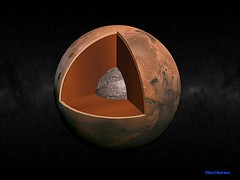Here is one question I would propose in regards to this theory. How does the new time lapse surface mapping effect the evaporation estimates of regular and heavy water accounting for certain variables from 4 billion years ago? One would have to study the properties on heavy water evaporation in different environmental models accounting for any variables such as asteroid collision, atmospheric differences, solar flares and the like from billions of years ago.
A primitive ocean on Mars held more water than Earth’s Arctic Ocean, and covered a greater portion of the planet’s surface than the Atlantic Ocean does on Earth, according to new results published today. An international team of scientists used ESO’s Very Large Telescope, along with instruments at the W. M. Keck Observatory and the NASA Infrared Telescope Facility, to monitor the atmosphere of the planet and map out the properties of the water in different parts of Mars’s atmosphere over a six-year period. These new maps are the first of their kind. The results appear online in the journal Science today.
About four billion years ago, the young planet would have had enough water to cover its entire surface in a liquid layer about 140 metres deep, but it is more likely that the liquid would have pooled to form an ocean occupying almost half of Mars’s northern hemisphere, and in some regions reaching depths greater than 1.6 kilometres.
“Our study provides a solid estimate of how much water Mars once had, by determining how much water was lost to space,” said Geronimo Villanueva, a scientist working at NASA’s Goddard Space Flight Center in Greenbelt, Maryland, USA, and lead author of the new paper. “With this work, we can better understand the history of water on Mars.
The new estimate is based on detailed observations of two slightly different forms of water in Mars’s atmosphere. One is the familiar form of water, made with two hydrogen atoms and one oxygen, H2O. The other is HDO, or semi-heavy water, a naturally occurring variation in which one hydrogen atom is replaced by a heavier form, called deuterium.
Thank you to the esteemed researchers at the ESO (European Southern Observatory) for producing and sharing such a thought provoking study. Read the full study here
Journal citations:
G. L. Villanueva, M. J. Mumma, R. E. Novak, H. U. Käufl, P. Hartogh, T. Encrenaz, A. Tokunaga, A. Khayat, M. D. Smith. Strong water isotopic anomalies in the martian atmosphere: Probing current and ancient reservoirs.
Photo Source bluedharma
